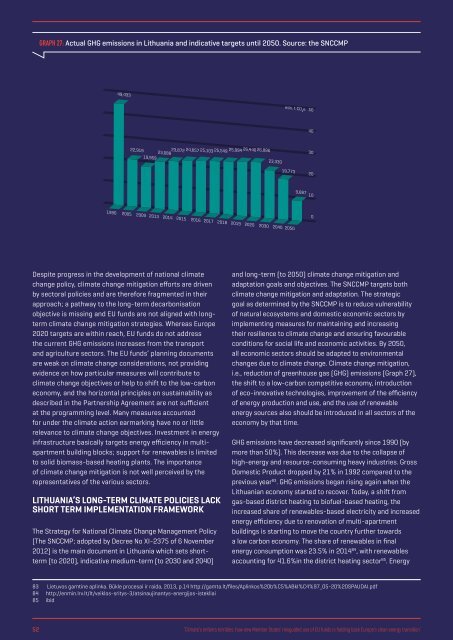ENFANTS TERRIBLES
enfants-terribles
enfants-terribles
You also want an ePaper? Increase the reach of your titles
YUMPU automatically turns print PDFs into web optimized ePapers that Google loves.
GRAPH 27: Actual GHG emissions in Lithuania and indicative targets until 2050. Source: the SNCCMP<br />
49,433<br />
mln. t CO 2<br />
e 50<br />
40<br />
22,919 23,088 23,872 24,657 25,103 25,549 25,994 26,44026,886 23,330<br />
19,959<br />
19,773<br />
30<br />
20<br />
9,887<br />
10<br />
1990 2005 2009 2013 2014 2015 2016 2017 2018 2019 2020 2030 2040 2050<br />
0<br />
Despite progress in the development of national climate<br />
change policy, climate change mitigation efforts are driven<br />
by sectoral policies and are therefore fragmented in their<br />
approach; a pathway to the long-term decarbonisation<br />
objective is missing and EU funds are not aligned with longterm<br />
climate change mitigation strategies. Whereas Europe<br />
2020 targets are within reach, EU funds do not address<br />
the current GHG emissions increases from the transport<br />
and agriculture sectors. The EU funds’ planning documents<br />
are weak on climate change considerations, not providing<br />
evidence on how particular measures will contribute to<br />
climate change objectives or help to shift to the low-carbon<br />
economy, and the horizontal principles on sustainability as<br />
described in the Partnership Agreement are not sufficient<br />
at the programming level. Many measures accounted<br />
for under the climate action earmarking have no or little<br />
relevance to climate change objectives. Investment in energy<br />
infrastructure basically targets energy efficiency in multiapartment<br />
building blocks; support for renewables is limited<br />
to solid biomass-based heating plants. The importance<br />
of climate change mitigation is not well perceived by the<br />
representatives of the various sectors.<br />
LITHUANIA’S LONG-TERM CLIMATE POLICIES LACK<br />
SHORT TERM IMPLEMENTATION FRAMEWORK<br />
The Strategy for National Climate Change Management Policy<br />
(The SNCCMP; adopted by Decree No XI-2375 of 6 November<br />
2012) is the main document in Lithuania which sets shortterm<br />
(to 2020), indicative medium-term (to 2030 and 2040)<br />
and long-term (to 2050) climate change mitigation and<br />
adaptation goals and objectives. The SNCCMP targets both<br />
climate change mitigation and adaptation. The strategic<br />
goal as determined by the SNCCMP is to reduce vulnerability<br />
of natural ecosystems and domestic economic sectors by<br />
implementing measures for maintaining and increasing<br />
their resilience to climate change and ensuring favourable<br />
conditions for social life and economic activities. By 2050,<br />
all economic sectors should be adapted to environmental<br />
changes due to climate change. Climate change mitigation,<br />
i.e., reduction of greenhouse gas (GHG) emissions (Graph 27),<br />
the shift to a low-carbon competitive economy, introduction<br />
of eco-innovative technologies, improvement of the efficiency<br />
of energy production and use, and the use of renewable<br />
energy sources also should be introduced in all sectors of the<br />
economy by that time.<br />
GHG emissions have decreased significantly since 1990 (by<br />
more than 50%). This decrease was due to the collapse of<br />
high-energy and resource-consuming heavy industries. Gross<br />
Domestic Product dropped by 21% in 1992 compared to the<br />
previous year 83 . GHG emissions began rising again when the<br />
Lithuanian economy started to recover. Today, a shift from<br />
gas-based district heating to biofuel-based heating, the<br />
increased share of renewables-based electricity and increased<br />
energy efficiency due to renovation of multi-apartment<br />
buildings is starting to move the country further towards<br />
a low carbon economy. The share of renewables in final<br />
energy consumption was 23.5% in 2014 84 , with renewables<br />
accounting for 41.6%in the district heating sector 85 . Energy<br />
83<br />
84<br />
85<br />
Lietuvos gamtinė aplinka. Būklė procesai ir raida, 2013, p.14 http://gamta.lt/files/Aplinkos%20b%C5%ABkl%C4%97_05-20%20SPAUDAI.pdf<br />
http://enmin.lrv.lt/lt/veiklos-sritys-3/atsinaujinantys-energijos-istekliai<br />
ibid<br />
52<br />
‘Climate’s enfants terribles: how new Member States’ misguided use of EU funds is holding back Europe’s clean energy transition’


